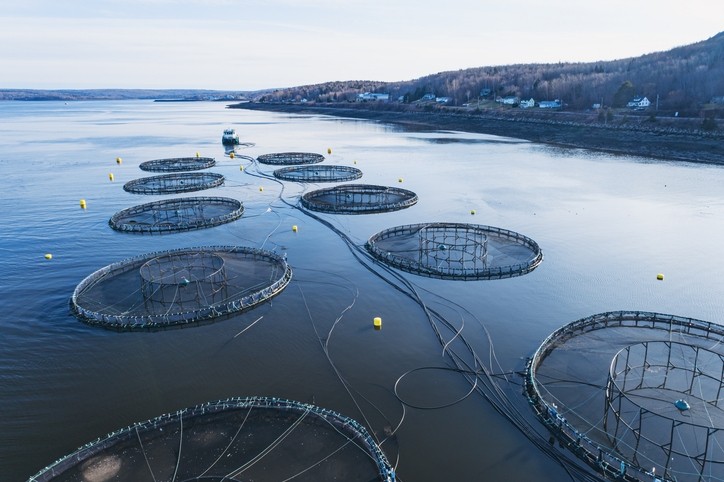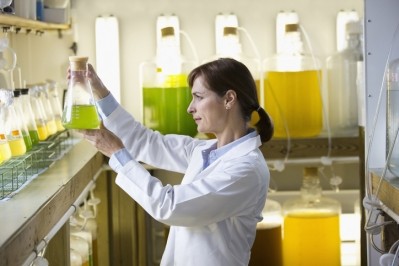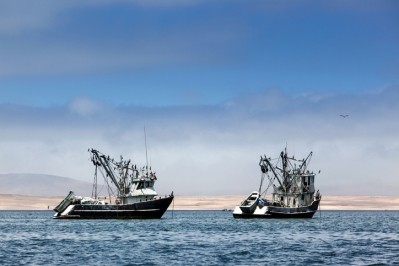How will industry meet demand for 100m tons of aqua feed by 2050?

The review was led by Dr Brett Glencross, the technical director at IFFO, along with a team of renowned fish nutritionists.
The authors assessed the current landscape of protein resources in aquaculture feed and explored multiple protein sources, dissecting their strengths, weaknesses, and potential synergies within feed formulations.
Their report, published in published in Reviews in Fisheries Science and Aquaculture, covers marine ingredients sourced from both forage fisheries and aquaculture by-products, processed animal proteins (PAPs), single-cell protein (SCP) resources from bacterial, yeast, fungal, or microalgal origins, and protein from cereals and oilseed sources.
Insights gleaned from an event ran in 2022 formed the basis of the review, Dr Glencross told this site. The pre-conference workshop at the International Symposium on Fish and Nutrition and Feeding (ISFNF) in Sorrento, Italy aimed to address the burgeoning interest in novel aqua proteins, recognizing a gap in comparative analysis against existing resources. It gathered up to 40 leading fish nutritionists, predominantly from industry.
Drawing from his experience as a former commercial formulator, Dr Glencross stressed the need for the participants to adopt an integrated approach, debunking the notion of substituting one resource for another. Instead, he advocated for evaluating all available options through a cost-sensitive lens, considering critical nutritional features.
Key topics were presented, leading to an extensive discussion spanning two hours.
The subsequent review offers a roadmap for enhancing feed security, he believes.
The paper emphasizes the significance of understanding the nuances of each ingredient, enabling greater adaptability and sustainability within the sector. Notably, the review highlights the challenges faced by certain new protein sources, such as SCPs, and insect meal, citing their limitations in scale and technological readiness, while also highlighting their advantages.
SWOT analysis
A SWOT analysis played a critical role in understanding the unique attributes of each ingredient. For instance, while soybean boasts scale, stability of supply, and consistent product quality, it may lack palatability for certain species. Conversely, fishmeal offers excellent palatability but faces limitations in supply. Recognizing these complementary strengths and weaknesses, the authors advocate for a collaborative approach to feed formulation, leveraging the strengths of various ingredients to optimize nutritional profiles.
On a call with FeedNavigator, Dr Glencross stressed the need for cost-effectiveness in feed formulation, a process that hinges on the economic viability of protein sources, considering factors such as dollars per unit of protein and energy value.
He noted that the feed industry operates on a principle of flexibility rather than wholesale substitution: “While novel proteins may tout additional features, their competitiveness rests on their ability to match or surpass the cost efficiency of traditional sources.”
Flagging production figures for novel proteins without aligning with the scale of typical aqua feed mills—60,000 to 120,000 tons annually—renders such claims moot.
“The emphasis lies not on replacement but on complementarity,” he reiterated. Rather than seeking to supplant existing resources, the focus should be on integrating novel proteins in a symbiotic relationship.

Non-competing nutrient sources
The review outlines key strategies to enhance feed security and sustainability. Future directions for the industry include “improving the management of existing resources to increase productivity, minimizing waste across the supply chain, and further developing non-competing resource production,” he told us.
In terms of non-competing nutrient sources, production of SCPs presents a significant advantage in utilizing inorganic nutrient sources, particularly nitrogen (N) and carbon (C), thereby ensuring that protein production from SCPs does not encroach upon potential food production for direct human consumption. This represents a distinct strength of SCPs over many grain resources, he commented.
“SCPs introduce novel material into the equation. They possess the ability to utilize inorganic nitrogen sources, including atmospheric nitrogen, which can be converted into ammonia. This ammonia can then be combined with organic compounds or even single-carbon molecules like carbon dioxide or methane to synthesize new protein. This process creates protein that doesn't naturally occur. In contrast, insects rely solely on existing protein sources for their own protein production.
“It's important to note that no animal on the planet creates protein from scratch. Instead, they absorb amino acids, rearrange them, and bind them together to form recycled protein,” remarked Dr Glencross.
Also weighing in on SCPs and insects was another review participant, Professor Margareth Øverland, Centre Director, Foods of Norway, The Norwegian University of Life Sciences (NMBU).
Microbes have several advantages, she claims. One being that they can convert a range of waste streams into high-value protein sources without putting pressure on agricultural land and water resources; they can be produced year-round independent of climate conditions; and they have the potential to use a wide range of feedstocks, such as residual waste streams from forestry and agriculture and waste gasses as input factors.
“But there are also barriers that need to be resolved before they can be upscaled to a commercially viable level that can meet the demand of the aquaculture industry. The main barriers are low production volumes and high costs, limited access to feedstock for upscaling and lack of regulatory framework for use of alternative feedstocks.”
Technologies to automate processes to reduce costs are also still lacking, continued the professor.
Moreover, energy costs present a significant constraint on the scaling up of production, given the energy-intensive nature of the fermentation and drying processes involved in SCP production. Thus, the imperative for access to affordable, renewable energy sources through industrial collaborations is evident. Energy pricing will play a pivotal role in driving the development of novel feed raw materials, emphasizing the importance of situating production facilities where such energy resources are readily available. This underscores the necessity for industrial partnerships, she remarked.
Additionally, there exists a dearth of large-scale infrastructure for expanding production capabilities, coupled with limited access to high-risk capital investment necessary for establishing manufacturing facilities. Addressing these challenges requires initiatives to secure high-risk investment funds and devise effective market introduction strategies, she said.
The initial production of the first 1,000 tons of products is anticipated to be costly, and the reluctance of potential customers to undertake such risks further exacerbates the bottleneck in market entry. Hence, concerted efforts are needed to facilitate access to capital and devise viable market introduction approaches, she commented.
Insect protein
Insects are increasingly recognized as promising feed ingredients due to their high protein and lipid content, offering a sustainable solution by converting low-value waste streams into valuable feed resources. Moreover, their minimal land and freshwater usage contribute to a circular aquaculture-based food system. With established technology for insect production and EU approval for use in fish, broiler chickens, and pig feeds, their potential is evident, continued Prof Øverland.
However, significant hurdles hinder the widespread adoption of insects in aquaculture feed, she said.
Insect protein production volumes remain insufficient to compete with mainstream commodities like fishmeal and soybean products, leading to higher insect material prices. Strict regulations governing feedstock/input factors for insect production pose a challenge, limiting the availability of suitable substrates and hindering scalability.
In the EU, current regulations restrict insect rearing to feedstocks that are also suitable for direct feeding to pigs and chickens. However, for sustainable insect production, future endeavors should focus on utilizing substrates that are not viable as feed resources, said the academic. Overcoming these obstacles is crucial for expanding insect production sustainably, she believes.
Additionally, ensuring compliance with welfare standards comparable to traditional farmed animals presents another challenge. Furthermore, the energy-intensive drying process adds to production costs, emphasizing the need for access to affordable renewable energy sources through industrial collaborations. Addressing these issues is key to realize the full potential of insects as a viable protein source for the aquaculture industry, she maintains.
Zero waste model
Looking to future directions, and the review stressed that efficient utilization of existing resources will be paramount, alongside the necessity for innovation in developing novel resources.
Initiatives like increased circularity, waste valorization and soil fertility management can bolster productivity and reduce environmental impact in fisheries and agriculture, outlined Dr Glencross.
“We should adopt the principle of zero waste in our approach. Currently, approximately 40% of marine ingredient resources are circular, which is a great news story. However, there is considerable room for improvement in maximizing the utilization of by-products to produce marine ingredients.”
Growth projections
Over the last two decades, the aquaculture sector has experienced remarkable growth. Projections from the UN’s Food and Agriculture Organization (FAO) indicate that global aquaculture production is set to more than double by 2050. This surge places increasing pressure on the feed sector to respond effectively.
“We're currently talking about the need for an additional 50 million tons of raw materials by 2050 to sustain aquafeed production. However, when considering algae, insects, and single-cell protein, can we realistically expect them to contribute another 40 million tons in the next 10 to 20 years? Honestly, I can't see it happening. So, what will meet this demand? Even with the potential of alternative protein sources, it's uncertain if they can fulfill such a substantial volume.
“I believe cropping will play a significant role in meeting this demand. There are ongoing advancements in crop genetics that lead to generalized gains in crop yields year after year.
“Additionally, I think there needs to be some redistribution of crop products from sectors with lower efficiency, such as cattle, pigs, and poultry. This reallocation aligns with the economic principle of gravity, where resources naturally flow towards more efficient uses. The most efficient use of resources in the feed sector is aquaculture. Currently, its FCR stands at less than 1.5, whereas for chickens it's around 2, and for pigs, it's around 3 to 1. Therefore, redirecting resources towards aquaculture makes more sense, as it ensures a much more efficient delivery and utilization of nutrients for the desired end product. Compared to feeding animals like cows or pigs, aquaculture offers significantly higher efficiency in converting nutrients into usable material.”















